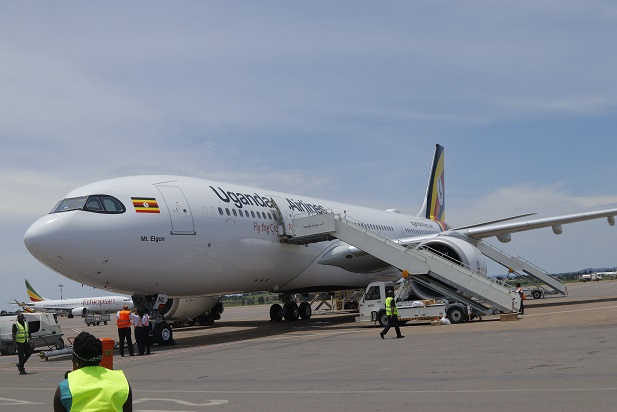Uganda Airlines’ Airbus A330-800 soared through the skies on its maiden flight from Entebbe to Mumbai on October 07, 2023
Uganda Airlines on October 7, 2023 launched direct flights from Entebbe International Airport (Uganda) to Mumbai Chhatrapati Shivaji Maharaj International Airport in India.
It was a historic day full of joy for the Indian community in Uganda, the business community and the tourism industry as Uganda Airlines’ Airbus A330-800 soared through the skies on its maiden flight from Entebbe to Mumbai.
The route is Uganda Airlines’ second service outside the African continent and the 12th across its network and joins a rapidly expanding network that offers travellers convenient connections to South, West, Central and Eastern Africa.
Dubai is the airline’s first international flight, having been launched in October 2021.
The inbound inaugural UR 430 flight with close to 100 passengers onboard was historic because it was the first direct flight between Uganda and India in over 50 years, easily connecting many Indians living in Uganda with their relatives back home in India.
But does this newly launched route make business/commercial sense for Uganda Airlines, the country’s flagship carrier?
The journey from Entebbe to Mumbai is about six and half hours, allowing travelers to save over six hours they have been losing through transit routes. It also helps passengers save money as a return ticket for the economy class is currently going for US$480.
Uganda Airlines will fly to Mumbai three times a week.
The return UR 431 will depart Mumbai on Sunday at 1:10am and arrive in Entebbe the same day at 5.50am.
The timings will slightly change on Mondays and Wednesdays, with inbound UR430 departing Entebbe at 20:15pm local time and arriving in Mumbai every Tuesday and Thursday at 05:55am. Meanwhile, the reciprocal UR 431 will depart Mumbai at 7:55am, arriving in Entebbe at 12:25 local time.
According to the airline, the schedule has been designed to fit neatly into its existing network to meet the needs of passengers who might wish to continue their journeys beyond Uganda.
Besides Mumbai, Uganda Airlines operates flights to Dubai, Johannesburg, Bujumbura, Nairobi, Mombasa, Zanzibar, Dar es Salaam, Kilimanjaro, Juba, Kinshasa and Mogadishu.
Adedayo Olawuyi, the Chief Commercial Officer at Uganda Airlines, says that the Mumbai route is a great milestone for the national carrier.
“We have been looking forward to this route for a very long time. From the numerical point of view, India is a market of 1.3 billion people. We are definitely looking into this market to help us grow our network considering the fact that we are not only flying into Entebbe, but we are also flying into other destinations.We are hoping that with the Mumbai route, we shall be able to achieve a form of network effect where we are able to get people from other destinations to come to Mumbai and get people from Mumbai to other destinations which will help build/ grow our numbers. This will make the route profitable,” Olawuyi said in an exclusive interview with Business Focus on the sidelines of the India-Uganda Business Forum held on 9th October 2023 at St. Regis Hotel, Mumbai.
He says the number of passengers flying between Mumbai and Entebbe stands at 76,000 annually.
“Based on the that figure, there was no direct service. We know every time you open a direct service, there’s a 20-25% stimulation in the number of passengers. This means that the number is going to grow from the current 76,000 to around 110,000 passengers by the end of next year,” Olawuyi further explains on the reasons behind opening up this route.
He says although they are not the only airline flying this route, they hope to get a lion’s share because they are the only ones offering a direct service.
“We’ll focus on the seamless service which we have been offering to Ugandans and other customers that fly with us to win the hearts of more people/passengers,” he says.
He adds that this coupled with other business, education and tourism opportunities, the over 35,000 Indian community in Uganda who travel to visit relatives and friends in India and bring their relatives and friends to Uganda, “there’s a lot of potential in this route and we are quite confident this route will workout for the airline.”
India’s High Commissioner to Uganda, Upender Singh Rawat, says the Indian community in Uganda has been a strong advocate of direct flights between Uganda and India because they have been going through other interconnecting/transit routes, thus making it more costly. He says that India is the second biggest investor in Uganda and that about 1,200 Ugandan students are studying in India. Medical tourism is also on the rise between Uganda and India. This, he says, will work in favour of Uganda Airlines.
Tourism, Business Opportunities
Irene Nanyombi, the Vice Chairperson of The Uganda Association of Travel Agents, says the Mumbai route opens Uganda not only to India, but also to the world.
“We anticipate an increased number of tourists from India into Uganda and we are looking forward to selling India as a destination. Uganda and India have cultural similarities, they share a lot of history. Uganda is virgin with multi-cultural, multi-national population; with its good food and everything, we are pretty sure selling it as a destination to India and the entire Asia is not going to be that hard,” Nanyombi says, adding: “ Uganda Airlines having a direct route to India has shortened the distance. It has saved passengers about seven hours because there’s no waiting due to stopovers. This will be a good addition to the travel industry. If the Governments of India and Uganda can work on making the visa process easy, there’s no reason why we can’t get more passengers.”
Apollo Muyanja Mbazzira, the Project Director-Young Africa Works at Private Sector Foundation Uganda (PSFU), says the history between Uganda India dates as far back as 1894 when Indians came to Uganda to build the Uganda Railways to connect Uganda (a land locked country) to other geographical locations and markets.
He says Uganda’s private sector will benefit from the Mumbai route because India is one of the largest markets globally.
“This trade route means that a new market has been opened for us as Ugandans by air. The plane (Airbus A330-800neo) that is coming to India has capacity to carry at least 18 metric tonnes of goods every time it lands into Mumbai and back to Entebbe. This means that members of the private sector in Uganda can move goods in and out of Entebbe with much relative ease than before,” Muyanja said in an exclusive interview with this website.
He adds that the Uganda market covers the entire East African Community.
“The EAC gives us a market of over 200 million people. We are encouraging our business counterparts here in India that when you’re doing business in Uganda, you have access to other countries within EAC that depend on Uganda for business connectivity purposes. These include South Sudan, DR Congo, Burundi among others,” he said.
He says PSFU has added the creative sector among the 12 different sectors it represents because of its massive opportunities.
“India is one of the countries with a vibrant creative sector. In India, the creative sector is worth 174bn Indian Rupees (UShs7.84 trillion). That’s huge. We shall find ways as PSFU in which the creative sector in India can connect with the creative sector in Uganda so that they can start doing collaborations with local artists in Uganda. We are going to create an avenue for music producers, film producers from India to come and share talent with their counterparts in Uganda,” Muyanja says.
Balancing Trade
It’s hoped that the Mumbai route will try to balance trade between the two countries.
At the moment, the trading opportunities are tilted in India’s favour. This perhaps explains why the maiden flight to Mumbai had less than a tonne of cargo, but the return flight had about five tonnes of cargo, a sign that Uganda is a big importer of India’s products especially the pharmaceuticals.
According to the Bank of Uganda (BoU) figures obtained by Business Focus, Uganda exported goods worth $94.54m to India in 2022, up from $93.45m in 2021. Earlier in 2020, Uganda earned $64.53m from exports to India, up from $62.27m in 2019.
BoU figures further show that Uganda imported goods worth $898.81m from India in 2022, up from $846.08m in 2021.
In 2020, India earned $766.58m from goods exported to Uganda, from $872.73m recorded a year earlier.
It’s hoped that this new route will result into more tourists and investors coming from India to Uganda.
India spends about $12.4 billion on travel alone annually.
Muyanja says one of the ways to deal with the trade imbalance is by sharing the information about the business opportunities in India to the business community in Uganda.
“Our people don’t have all the information they need to know about this market; the size and the opportunities available in India.
India doesn’t produce everything that they need. We shall focus our farmers on things where Uganda has a comparative advantage so that these commodities come to India as fresh or processed commodities. In terms of flower growing, we may have a higher advantage; we are at the Equator, so we have the weather advantage,” Muyanja says.
Uganda’s High Commissioner to India, Upender says that agricultural produce from Uganda mainly avocados and pineapples can easily find market in India.






